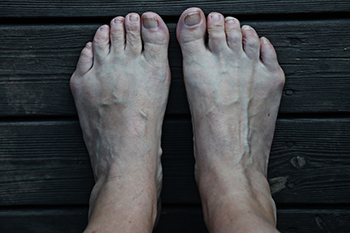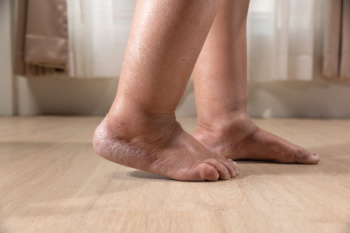Connect With Us
Blog
Items filtered by date: April 2025
Are Bunions Affecting Your Everyday Life?
The Importance of Wearing the Right Shoe Size

Wearing the correct shoe size is essential for foot health, comfort, and overall mobility. Shoes that fit properly should provide enough space at the toe box, allow your foot to rest naturally, and feel secure without being tight. Signs that shoes may be the wrong size include blisters, pressure points, pain, or excessive movement of the heel while walking. It is important to check how your feet feel at the end of the day when they are slightly swollen, as this can give a better sense of fit. Wearing shoes that are too small or too large can lead to long-term issues, such as bunions, hammertoes, and joint pain. Choosing the correct size helps support proper alignment, reduces fatigue, and promotes healthier movement with each step you take. If you have developed foot pain from wearing the wrong size shoes, it is suggested that you contact a podiatrist who can treat various foot conditions, and better guide you on determining your correct shoe size.
It is important to find shoes that fit you properly in order to avoid a variety of different foot problems. For more information about treatment, contact one of our podiatrists from DM Foot & Ankle Associates . Our doctors will treat your foot and ankle needs.
Proper Shoe Fitting
Shoes have many different functions. They cushion our body weight, protect our feet, and allow us to safely play sports. You should always make sure that the shoes you wear fit you properly in order to avoid injuries and deformities such as: bunions, corns, calluses, hammertoes, plantar fasciitis, stress fractures, and more. It is important to note that although a certain pair of shoes might be a great fit for someone else, that doesn’t mean they will be a great fit for you. This is why you should always try on shoes before buying them to make sure they are worth the investment. Typically, shoes need to be replaced ever six months to one year of regular use.
Tips for Proper Shoe Fitting
- Select a shoe that is shaped like your foot
- Don’t buy shoes that fit too tight, expecting them to stretch to fit
- Make sure there is enough space (3/8” to ½”) for your longest toe at the end of each shoe when you are standing up
- Walk in the shoes to make sure they fit and feel right
- Don’t select shoes by the size marked inside the shoe, but by how the shoe fits your foot
The shoes you buy should always feel as good as they look. Shoes that fit properly will last longer, feel better, and improve your way of life each day.
If you have any questions please contact our office located in Lemont, IL . We offer the newest diagnostic and treatment technologies for all your foot and ankle needs.
How Alcohol Can Affect Foot Health

Alcohol consumption can have several surprising effects on foot health, often going unnoticed until discomfort begins. Drinking alcohol may lead to a sensation of heaviness in the limbs, making the feet and legs feel sluggish or difficult to move. It can also contribute to foot swelling due to fluid retention and impaired circulation. Regular alcohol use may increase uric acid levels in the body, raising the risk of developing gout, a painful condition that often targets the joints of the big toe. Additionally, alcohol can dehydrate the body, leading to dry, scaly skin on the feet, which may crack or become irritated. Paying attention to how alcohol impacts the body, including the feet, is important for maintaining overall wellness. If you have any kind of foot pain, it is suggested that you confer with a podiatrist who can treat various foot conditions, and offer appropriate treatment solutions.
Foot Pain
Foot pain can be extremely painful and debilitating. If you have a foot pain, consult with one of our podiatrists from DM Foot & Ankle Associates . Our doctors will assess your condition and provide you with quality foot and ankle treatment.
Causes
Foot pain is a very broad condition that could be caused by one or more ailments. The most common include:
- Bunions
- Hammertoes
- Plantar Fasciitis
- Bone Spurs
- Corns
- Tarsal Tunnel Syndrome
- Ingrown Toenails
- Arthritis (such as Gout, Rheumatoid, and Osteoarthritis)
- Flat Feet
- Injury (from stress fractures, broken toe, foot, ankle, Achilles tendon ruptures, and sprains)
- And more
Diagnosis
To figure out the cause of foot pain, podiatrists utilize several different methods. This can range from simple visual inspections and sensation tests to X-rays and MRI scans. Prior medical history, family medical history, and any recent physical traumatic events will all be taken into consideration for a proper diagnosis.
Treatment
Treatment depends upon the cause of the foot pain. Whether it is resting, staying off the foot, or having surgery; podiatrists have a number of treatment options available for foot pain.
If you have any questions, please feel free to contact our office located in Lemont, IL . We offer the newest diagnostic and treatment technologies for all your foot care needs.
All About Bunions on the Pinky Toe

A bunion on the pinky toe, also called a bunionette, forms when the fifth metatarsal bone begins to push outward, causing a noticeable bump at the base of the smallest toe. This condition is often linked to wearing pointy shoes that are too tight in the toe box, which forces the pinky toe inward and places repeated pressure on the outer edge of the foot. Over time, this can lead to redness, swelling, and pain. Although some people may not feel discomfort in the early stages, the deformity can become more painful as the bunionette progresses. A podiatrist can diagnose a bunionette through a physical exam and imaging, such as X-rays, to assess bone alignment. In some cases, a podiatrist may recommend shoe changes, padding, or orthotic support to reduce discomfort. When a bunionette is severe and causes persistent pain, surgery may be considered to correct the alignment of the bone. If you have a painful bunion at your pinky toe joint, it is suggested that you make an appointment with a podiatrist for an exam and treatment.
If you are suffering from bunion pain, contact one of our podiatrists of DM Foot & Ankle Associates . Our doctors can provide the care you need to keep you pain-free and on your feet.
What Is a Bunion?
Bunions are painful bony bumps that usually develop on the inside of the foot at the joint of the big toe. As the deformity increases over time, it may become painful to walk and wear shoes. Women are more likely to exacerbate existing bunions since they often wear tight, narrow shoes that shift their toes together. Bunion pain can be relieved by wearing wider shoes with enough room for the toes.
Causes
- Genetics – some people inherit feet that are more prone to bunion development
- Inflammatory Conditions - rheumatoid arthritis and polio may cause bunion development
Symptoms
- Redness and inflammation
- Pain and tenderness
- Callus or corns on the bump
- Restricted motion in the big toe
In order to diagnose your bunion, your podiatrist may ask about your medical history, symptoms, and general health. Your doctor might also order an x-ray to take a closer look at your feet. Nonsurgical treatment options include orthotics, padding, icing, changes in footwear, and medication. If nonsurgical treatments don’t alleviate your bunion pain, surgery may be necessary.
If you have any questions, please feel free to contact our office located in Lemont, IL . We offer the newest diagnostic and treatment technologies for all your foot care needs.
Types of Ingrown Toenail Surgery

Ingrown toenails occur when the edge of a toenail, usually on the big toe, grows into the surrounding skin. This can lead to pain, swelling, and infection. Surgery for ingrown toenails is often recommended when the problem does not improve or keeps coming back. A podiatrist may perform a procedure called a wedge excision, where part of the toenail and the tissue it grows from are removed. In more severe cases, the entire nail may be taken out, termed nail avulsion. A chemical or heat may be used afterward to prevent the nail from growing back, a process known as nail-bed ablation. Another option, Zadek’s procedure, involves removing both the nail and the underlying tissue that causes the nail to regrow. Ingrown toenail surgery is typically done under local anaesthetic and takes about 10 minutes. Infection or toenail regrowth can occur, but many patients experience no such repercussions. If you are experiencing ongoing pain from an ingrown toenail, it is suggested that you schedule an appointment with a podiatrist for an exam, treatment, and possible surgery.
Ingrown toenails may initially present themselves as a minor discomfort, but they may progress into an infection in the skin without proper treatment. For more information about ingrown toenails, contact one of our podiatrists of DM Foot & Ankle Associates . Our doctors can provide the care you need to keep you pain-free and on your feet.
Ingrown Toenails
Ingrown toenails are caused when the corner or side of a toenail grows into the soft flesh surrounding it. They often result in redness, swelling, pain, and in some cases, infection. This condition typically affects the big toe and may recur if it is not treated properly.
Causes
- Improper toenail trimming
- Genetics
- Improper shoe fitting
- Injury from pedicures or nail picking
- Abnormal gait
- Poor hygiene
You are more likely to develop an ingrown toenail if you are obese, have diabetes, arthritis, or have any fungal infection in your nails. Additionally, people who have foot or toe deformities are at a higher risk of developing an ingrown toenail.
Symptoms
Some symptoms of ingrown toenails are redness, swelling, and pain. In rare cases, there may be a yellowish drainage coming from the nail.
Treatment
Ignoring an ingrown toenail can have serious complications. Infections of the nail border can progress to a deeper soft-tissue infection, which can then turn into a bone infection. You should always speak with your podiatrist if you suspect you have an ingrown toenail, especially if you have diabetes or poor circulation.
If you have any questions, please feel free to contact our office located in Lemont, IL . We offer the newest diagnostic and treatment technologies for all your foot care needs.
Common Causes of Swelling in the Feet

Swelling in the feet can result from various factors that affect circulation and fluid balance. Long periods of sitting or standing can lead to fluid buildup due to reduced blood flow, causing discomfort and puffiness. Certain medical conditions, including heart, kidney, or liver disease, can contribute to swelling by affecting the body's ability to regulate fluids. A high salt intake may also cause water retention, leading to noticeable swelling in the lower extremities. Blood clots can obstruct circulation, resulting in one-sided swelling accompanied by pain or redness. Additionally, wearing tight footwear restricts movement and can worsen fluid accumulation. A sedentary lifestyle may also contribute to poor circulation, increasing the risk of swelling. If you notice your feet and ankles are swollen, it is suggested that you visit a podiatrist who can determine what the cause is, and offer appropriate relief and treatment solutions.
Swollen feet can be a sign of an underlying condition. If you have any concerns, contact one of our podiatrists of DM Foot & Ankle Associates . Our doctors can provide the care you need to keep you pain-free and on your feet.
Swollen feet are a common ailment among pregnant women and people who stand or sit for extended periods. Aging may increase the possibility of swollen feet and patients who are obese often notice when their feet are swelling too. There may be medical reasons why swollen feet occur:
- Phlebitis - A condition that causes the veins to become inflamed and can also cause leg pain.
- Liver disease - This may lead to low blood levels of albumin which is a protein. This can cause fluid in the blood to pass into the tissues and several areas of the body can become swollen.
- Heart failure - When the heart doesn’t pump properly the blood that is normally pumped back to the heart can pool in the veins of the legs causing swollen feet.
- Kidney disease - One of the main functions of the kidneys is releasing excess fluid in the body. This type of condition can make it difficult for the kidneys to function properly, and as a result the feet may become swollen.
- Deep-vein thrombosis (DVT)- This is a serious condition where blood clots form in the veins of the legs. They can block the return of blood from the legs to the heart which may cause the feet to swell. It is important to be treated by a podiatrist if this condition is present.
Swollen feet can also be caused by bone and tendon conditions, including fractures, arthritis, and tendinitis. Additionally, there may be skin and toenail conditions and an infection may cause the feet to swell. Patients who take medicine to treat high blood pressure may be prone to getting swollen feet.
Many patients elevate their feet to help relieve the swelling and this is generally a temporary remedy. When a podiatrist is consulted the reason behind the swelling can be uncovered and subsequently treated.
If you have any questions please contact our office located in Lemont, IL . We offer the newest diagnostic and treatment technologies for all your foot and ankle needs.
